明孝陵英文导游词
南京明孝陵导游词英文
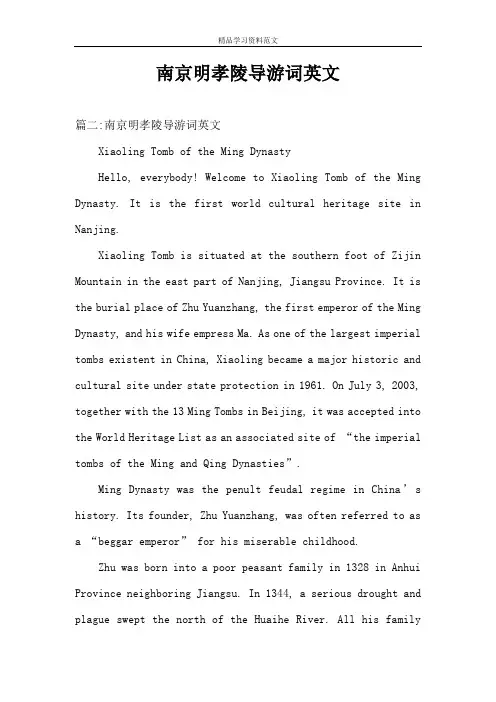
南京明孝陵导游词英文篇二:南京明孝陵导游词英文Xiaoling Tomb of the Ming DynastyHello, everybody! Welcome to Xiaoling Tomb of the Ming Dynasty. It is the first world cultural heritage site in Nanjing.Xiaoling Tomb is situated at the southern foot of Zijin Mountain in the east part of Nanjing, Jiangsu Province. It is the burial place of Zhu Yuanzhang, the first emperor of the Ming Dynasty, and his wife empress Ma. As one of the largest imperial tombs existent in China, Xiaoling became a major historic and cultural site under state protection in 1961. On July 3, 2003, together with the 13 Ming Tombs in Beijing, it was accepted into the World Heritage List as an associated site of “the imperial tombs of the Ming and Qing Dynasties”.Ming Dynasty was the penult feudal regime in China’s history. Its founder, Zhu Yuanzhang, was often referred to as a “beggar emperor” for his miserable childhood.Zhu was born into a poor peasant family in 1328 in Anhui Province neighboring Jiangsu. In 1344, a serious drought and plague swept the north of the Huaihe River. All his familymembers died in succession during the disaster. To support himself, he entered a monastery near his village to be a monk at the age of 17, but before long he was sent out to beg alms for survival until 1348. At that time, peasant uprisings against the oppression of the Yuan Dynasty broke out in many places. One of the strongest forces was the Red Tie Army, so named because every soldier wore a red tie on the neck. At the age of 24, Zhu ran away from the monastery and joined the army. There he fought bravely and showed great talent as a strategist. He was quickly promoted to be one of the leading generals and married the commander’s adopted daughter. When the commander died, he succeeded him. Under his leadership, the army became stronger. After wiping out all the other rivals。
新明孝陵导游词
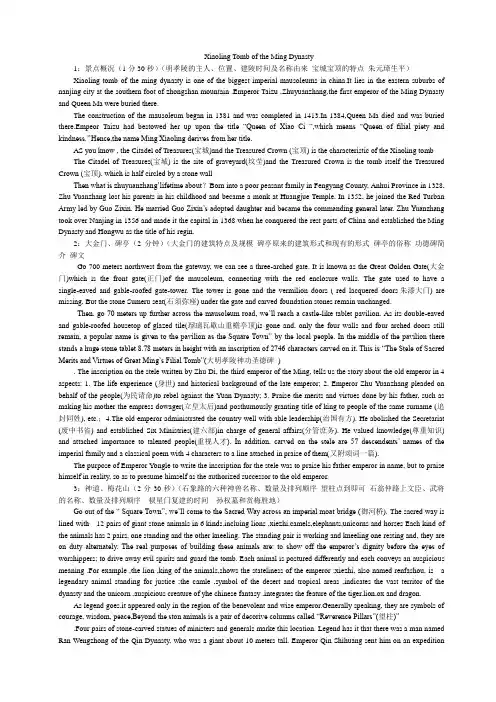
Xiaoling Tomb of the Ming Dynasty1:景点概况(1分30秒)(明孝陵的主人、位置、建陵时间及名称由来宝城宝顶的特点朱元璋生平)Xiaoling tomb of the ming dynasty is one of the biggest imperial mausoleums in china.It lies in the eastern suburbs of nanjing city at the southern foot of zhongshan mountain .Emperor Taizu ,Zhuyuanzhang,the first emperor of the Ming Dynasty and Queen Ma were buried there.The construction of the mausoleum began in 1381 and was completed in 1413.In 1384,Queen Ma died and was buried there.Empeor Taizu had bestowed her up upon the title “Queen of Xiao Ci “,which means “Queen of filial piety and kindness.’’Hence,the name Ming Xiaoling derives from her title.AS you know , the Citadel of Treasures(宝城)and the Treasured Crown (宝顶) is the characteristic of the Xiaoling tomb The Citadel of Treasures(宝城) is the site of graveyard(坟茔)and the Treasured Crown is the tomb itself the Treasured Crown (宝顶), which is half circled by a stone wallThen what is zhuyuanzhang’lifetime about?Born into a poor peasant family in Fengyang County, Anhui Province in 1328, Zhu Y uanzhang lost his parents in his childhood and became a monk at Huangjue Temple. In 1352, he joined the Red Turban Army led by Guo Zixin. He married Guo Zixin’s adopted daughter and became the commanding general later. Zhu Y uanzhang took over Nanjing in 1356 and made it the capital in 1368 when he conquered the rest parts of China and established the Ming Dynasty and Hongwu as the title of his regin.2:大金门、碑亭(2分钟)(大金门的建筑特点及规模碑亭原来的建筑形式和现有的形式碑亭的俗称功德碑简介碑文Go 700 meters northwest from the gateway, we can see a three-arched gate. It is known as the Great Golden Gate(大金门)which is the front gate(正门)of the mausoleum, connecting with the red enclosure walls. The gate used to have a single-eaved and gable-roofed gate-tower. The tower is gone and the vermilion doors ( red lacquered doors朱漆大门) are missing. But the stone Sumeru seat(石须弥座) under the gate and carved foundation stones remain unchanged.Then, go 70 meters up further across the mausoleum road, we’ll reach a castle-like tablet pavilion. As its double-eaved and gable-roofed housetop of glazed tile(瑠璃瓦歇山重檐亭顶)is gone and, only the four walls and four arched doors still remain, a popular name is given to the pavilion as the Square Town” by the local people. In the middle of the pavilion t here stands a huge stone tablet 8.78 meters in height with an inscription of 2746 characters carved on it. This is “The Stele of S acred Merits and Virtues of Great Ming’s Filial Tomb”(大明孝陵神功圣德碑). The inscription on the stele written by Zhu Di, the third emperor of the Ming, tells us the story about the old emperor in 4 aspects: 1. The life experience (身世) and historical background of the late emperor; 2. Emperor Zhu Y uanzhang pleaded on behalf of the people(为民请命)to rebel against the Yuan Dynasty; 3. Praise the merits and virtues done by his father, such as making his mother the empress dowager(立皇太后)and posthumously granting title of king to people of the same surname (追封同姓), etc.;4.The old emperor administrated the country well with able leadership(治国有方). He abolished the Secretariat (废中书省) and established Six Ministries(建六部)in charge of general affairs(分管庶务). He valued knowledge(尊重知识) and attached importance to talented people(重视人才). In addition, carved on the stele are 57 descendents’ names of the imperial family and a classical poem with 4 characters to a line attached in praise of them(又附颂词一篇).The purpose of Emperor Yongle to write the inscription for the stele was to praise his father emperor in name, but to praise himself in reality, so as to presume himself as the authorized successor to the old emperor.3:神道、梅花山(2分30秒)(石象路的六种神兽名称、数量及排列顺序望柱点到即可石翁仲路上文臣、武将的名称、数量及排列顺序棂星门复建的时间孙权墓和赏梅胜地)Go out of the “ Square Town”, we’ll come to the Sacred Way across an imperial moat bridge (御河桥). The sacred way is lined with 12 pairs of giant stone animals in 6 kinds.incluing lions ,xiezhi,camels,elephants,unicorns and horses Each kind of the animals has 2 pairs, one standing and the other kneeling. The standing pair is working and kneeling one resting and, they are on duty alternately. The real purposes of building these animals are: to show off the emperor’s dignity before the eyes of worshippers; to drive away evil spirits and guard the tomb. Each animal is postured differently and each conveys an auspicious meaning .For example ,the lion ,king of the animals,shows the stateliness of the emperor ;xiezhi, also named renfashou, is a legendary animal standing for justice ;the camle ,symbol of the desert and tropical areas ,indicates the vast territor of the dynasty and the unicorn ,auspicious creature of yhe chinese fantasy ,integrates the feature of the tiger,lion,ox and dragon.As legend goes,it appeared only in the region of the benevolent and wise emperor.Generally speaking, they are symbols of courage, wisdom, peace,Beyond the ston animals is a pair of decorive columns called “Reverence Pillars”(望柱)”.Four pairs of stone-carved statues of ministers and generals marke this location. Legend has it that there was a man named Ran Wengzhong of the Qin Dynasty, who was a giant about 10 meters tall. Emperor Qin Shihuang sent him on an expeditionagainst Xiongnu, an ancient nationality in north China. After he died, a bronze statue was cast for him in Xianyang Palace. Since the time all the bronze statues and stone statues put before a tomb have been called Weng Zhong. At the end of the sacred avenue, there used to be a gate named Lingxing Gate with three arches. and it was rebuilted in 2007 January 30 ..From here the Sacred Way turns into a north-south direction and becomes known as Wengzhong Road nd circles a small hill planted with thousands of plum trees. It is the Plum Hill, which is the tomb of Sun Quan, the king of the Eastern Wu kingdom. It is said that some royal ministers of the Ming suggested moving the tomb aw ay when the emperor’s mausoleum was under construction. But the emperor did not agree and praised Sun Quan to be a good fellow and let him stay to be the concierge of his tomb. The plum hill is now a wonderful site for local people to admire plum blossom in spring when the trees are blooming.4:金水桥、陵门、碑殿(2分30秒)(过金水桥点到即可陵门建筑特点“特别告示”碑及六国文字碑殿内五块石碑的名称及内容)Passing jinshui Bridge , we’ll come to the Tomb Gate(陵门). The arch gate has 5 doorways, with yellow glazed tiles, red walls and doors. But this gate was rebuilt in 1999. The lintel of the gate is engraved with three Chinese characters meaning “Xiaoling Tomb of the Ming Dynasty or The Ming’s Filial Tomb”. The name “Xiaoling” was given by the emperor himself, but the word “Ming” was added to later in the Qing times.At the foot of the gate,there is a “special notice “stone tablet carved in six languages(Japanese,German,ltalian,English,Frenchand Russian),notifying visitors of the importance of the mausoleum.Inside the gate is the Imperial Tablet Hall.There are five tablets displayed in it .In the middle tablet ,it is carved on four chinese characters”Zhi Long Tang Song “,meaning the state of Ming taizu even better than emperor Taizong of the Tang Dynasty and Emperor Taizu of the Song Dynasty ,two successful emperors in the chinese history written by Kangxi during his third inspection tour to southern China .Cao Yin ,grandfather of Cao xueqin a,grate writer inscribed it on the tablet .Besides the middle big tablet ,there are also two tablets inscribed with a poem composed by the emperor. Qian Long. At each back of the two steles there are two sleeping tomb stones carved with the titles wrritened by Vicery of laingjiang in Qing dynasty .5:享殿遗址(1分30秒)(享殿过去和现在的用途原来的规模及现在可见的景观)Go out of the pavilion, we’ll come t o the site of xiang hall. The original hall was very large in a width of 9 rooms(九开间). It was used to enshrine Emperor Zhu Yuanzhang and his empress.while now it is a pace to vist and a shop dealing in souvenis.Figures og Emperor taizu and Queen Ma are hanging inside on the wall.The hall was destroyed yet its 56 stone column bases are still there. There are also three stone-carved patterns laid between the two-way parallel flights of stairs outside the hall ,depicting various scenes like “the two dragons playing with a pearl,””the blazing sun over the country “and “a heavenly steed soaring across the skies.” On both sides of the Filial Hall there used to have a number of side halls for enshrining imperial concubines buried with the dead emperor(陪葬妃子). The present Filial Hall with only three rooms is much smaller than the original. It was rebuilt and twicely restored for the tomb guards during the Tongzhi reign of the Qing Dynasty. But now it only has some portraits of the emperor and the crown prince(太子) done by later generations hanging on the walls.6方城,明楼,宝城、宝顶(2分钟)(方城明楼的布局建筑特色宝城、宝顶的规模、形状和建造特点)Then through the Inner Red Gate,you will come to the Fang Cheng .The base of Fang Cheng has an arched passageway in the middle. Along the 54 steps, you will see t he south wall of the tomb carved with seven Chinese characters meaing “this hill is the tomb of Emperor Taizu of Ming “,which was written in the early time of Republic of Chian.Here,it is divided into two paths,one is leading up to Ming Tower.Ming Tower faces south with three arched entrances facing east ,west ,and north respective.The roof of ming tower has collapsed over the years,but the walls remians.In 2009,the government rebuilt the roof in order to keep it better. The other path leads to Baocheng ,which refers to the wall around the tomb.The top of the mausoleum is situated at Dulongfu of Wanzhu Peak at the southern foot of Zhongshan Mountain .Baoding is covered by a large circled earthen mound ,325-400meters in diameter.The tomb of Emperor Taizu and Queen Ma is just beneath.Xiaoling tomb of the Ming Dynasty is renowed for its unique design,its eminent status,its amazing beauty and its magnificent scale.It is the milestone in the historical development of Chinese mausoleums.As an extension of the “imp erial tombs of the Ming and Qing dynasties”,it is listed by UNESCO as a world cultural heritage site.。
南京明孝陵英语作文
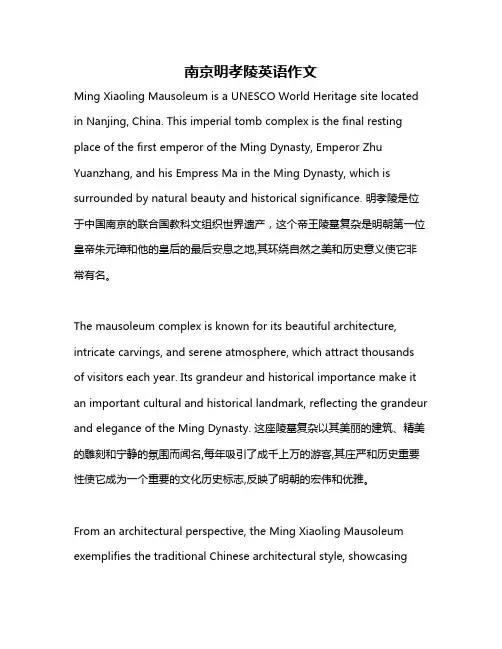
南京明孝陵英语作文Ming Xiaoling Mausoleum is a UNESCO World Heritage site located in Nanjing, China. This imperial tomb complex is the final resting place of the first emperor of the Ming Dynasty, Emperor Zhu Yuanzhang, and his Empress Ma in the Ming Dynasty, which is surrounded by natural beauty and historical significance. 明孝陵是位于中国南京的联合国教科文组织世界遗产,这个帝王陵墓复杂是明朝第一位皇帝朱元璋和他的皇后的最后安息之地,其环绕自然之美和历史意义使它非常有名。
The mausoleum complex is known for its beautiful architecture, intricate carvings, and serene atmosphere, which attract thousands of visitors each year. Its grandeur and historical importance make it an important cultural and historical landmark, reflecting the grandeur and elegance of the Ming Dynasty. 这座陵墓复杂以其美丽的建筑、精美的雕刻和宁静的氛围而闻名,每年吸引了成千上万的游客,其庄严和历史重要性使它成为一个重要的文化历史标志,反映了明朝的宏伟和优雅。
From an architectural perspective, the Ming Xiaoling Mausoleum exemplifies the traditional Chinese architectural style, showcasingintricate and magnificent structures such as the Sacred Way, the Elephant Road, and the main tomb structure. These architectural marvels not only reflect the artistic achievements of the time but also serve as a testament to the grandeur and power of the Ming Dynasty. 从建筑的角度看,明孝陵展示了传统的中国建筑风格,包括神道、大象路和主墓建筑等复杂而宏伟的建筑结构,这些建筑奇迹不仅反映了当时的艺术成就,而且也见证了明朝的宏伟和力量。
南京明孝陵英语作文
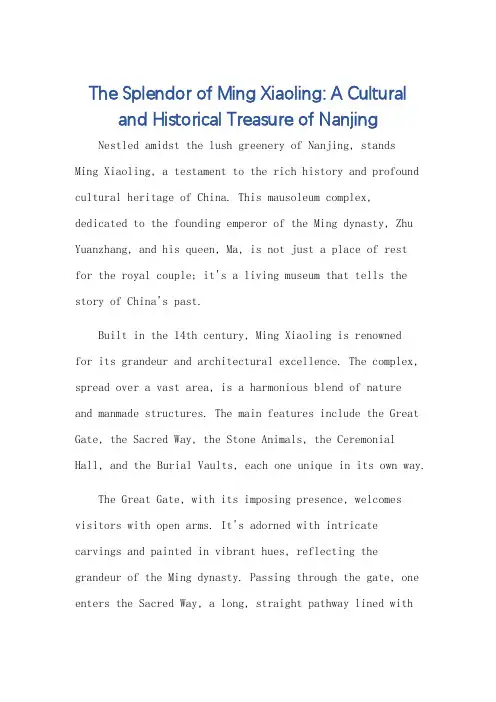
The Splendor of Ming Xiaoling: A Cultural and Historical Treasure of NanjingNestled amidst the lush greenery of Nanjing, standsMing Xiaoling, a testament to the rich history and profound cultural heritage of China. This mausoleum complex, dedicated to the founding emperor of the Ming dynasty, Zhu Yuanzhang, and his queen, Ma, is not just a place of restfor the royal couple; it's a living museum that tells the story of China's past.Built in the 14th century, Ming Xiaoling is renownedfor its grandeur and architectural excellence. The complex, spread over a vast area, is a harmonious blend of natureand manmade structures. The main features include the Great Gate, the Sacred Way, the Stone Animals, the Ceremonial Hall, and the Burial Vaults, each one unique in its own way. The Great Gate, with its imposing presence, welcomes visitors with open arms. It's adorned with intricate carvings and painted in vibrant hues, reflecting the grandeur of the Ming dynasty. Passing through the gate, one enters the Sacred Way, a long, straight pathway lined withstone animals, each symbolizing a different aspect of royal power and dignity.The Ceremonial Hall, located at the heart of the complex, is a magnificent structure that once hosted royal ceremonies and rites. Its interior is adorned withbeautiful murals and carvings, depicting scenes from Chinese mythology and history.But the real highlight of Ming Xiaoling is the Burial Vaults, where the remains of Zhu Yuanzhang and his queen rest. These vaults, carved out of solid rock, are a testament to the advanced engineering skills of the Ming dynasty. They are adorned with intricate carvings and paintings, telling the story of the emperor's life and reign.But Ming Xiaoling is not just about architecture and history; it's also about the beauty of nature. Surrounded by lush green hills and serene lakes, the complex offers a peaceful and serene atmosphere that is truly refreshing. Visitors can take a leisurely walk through the gardens, admire the scenic views, and relish the tranquility that this place offers.Ming Xiaoling is not just a place to visit; it's an experience. It offers a window into the rich history and profound culture of China, allowing visitors to connect with their past and appreciate the legacy of their ancestors. Whether you're an architecture enthusiast, a history buff, or just looking for a peaceful getaway, Ming Xiaoling is sure to leave a lasting impression.**南京明孝陵:文化与历史的瑰宝**南京,这座历史悠久的城市,孕育着无数文化和历史的瑰宝。
南京明孝陵英文导游词
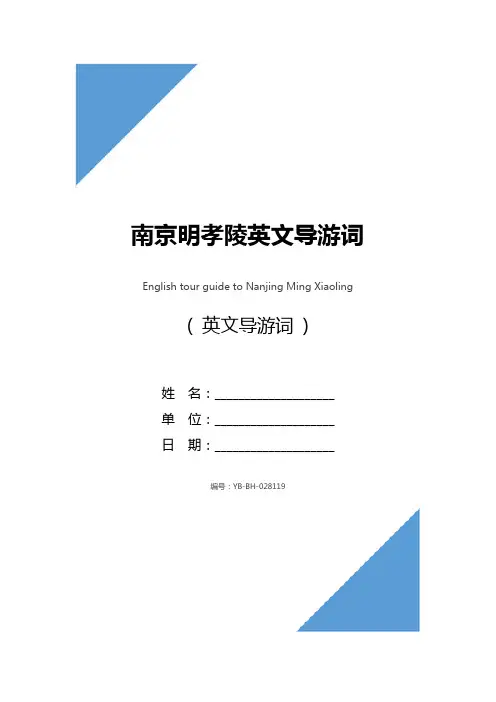
( 英文导游词)姓名:____________________单位:____________________日期:____________________编号:YB-BH-028119南京明孝陵英文导游词English tour guide to Nanjing Ming Xiaoling南京明孝陵英文导游词南京明孝陵导游词英文Ming Xiaoling Mausoleum is the first emperor of the Ming Dynasty and the queen Zhu Yuanjin Ma burial tomb, which is located in the southern foot of the purple mountain long Fu play in Mount Everest, Nanjing is the largest and one of the best preserved imperial tombs.So far more than 600 years of history.The emperors in ancient China chose the site of the mausoleum very carefully, and paid special attention to choosing the land of "Ji Di", that is, the place of geomantic omen.Every time I go out the site, in addition to sending one or two court officials, but also absorb the knowledge of geography, will see the alchemist in Feng shui.After selecting the mausoleum, the emperor had to examine the scene himself and was satisfied with it and was finally finalized.Soon after Zhu Yuanzhang ascended the throne, he was concerned about the "paradise" after his death, and began to plan the construction of the mausoleum.It is said that he has called Liu Bowen, Xu Da, Tang He, and other ministers todiscuss site selection.Five people agreed to write their respective best burial sites on paper and then open them at the same time.The results are written, Great minds think alike., Dulong Fu Mount Everest ".So the site of the tomb of Zhu Yuanjin was thus fixed.Dulong Fu is a hill located beneath the Zijin Mountain peak, 150 meters high, about 400 meters in diameter, is like a huge natural grave.Chinese feudal emperor often put themselves as sons of the heaven, to build the tomb in Dulong Fu, is in line with the requirements of the feudal superstition.Ming Xiaoling Mausoleum Yu Wu nine years (1376) began to build, build competent mausoleum engineering enterprises is "Dudu Fu Li xin.At that time, a large number of migrant workers were employed, and dozens of temples were left behind by their predecessors.Since the Eastern Jin Dynasty and the Southern Dynasties, Buddhism has been widely spread in China. The emperor of Wu even regards Buddhism as a national religion, so the temples in Nanjing are numerous.In the Eastern Jin Dynasty, there were more than 300 Buddhist temples, nearly 500 in the Southern Dynasties, and 100 thousand monks.His poetry in the Tang Dynasty: "in the four hundred and eighty temple, how many loutai yanyu."It was the portrayal of the flourishing Buddhist temples in Nanjing.In addition to moving to the temple, even moved a lot of previous tombs.But when moving to the Three Kingdoms, the tomb of Sun Quan (now on Mount Mei Shan in Nanjing), Zhu Yuanjin said, "SunQuan is a true man, keeping him as a gatekeeper."."It was not removed.Hongwu fifteen years (1382), the first phase of the project completed, coincided with the empress Ma's death, Zhu Yuanjin held a grand funeral for her, and the coffin burial tomb, called her "Xiaoci Queen", which is also the name of the tomb.In 1383, the main project of the tomb built hall.In 1392, the crown prince ZhuBiao died and was buried in the tomb of the East, called dongling.Hongwu thirty-one years (1398) built "Ming Tomb magic holiness monument", the construction of the mausoleum engineering ended, the project took 23 years.Before the death of Zhu Yuanjin, had left a testament; "funeral to frugality, no Jin, change because of the tomb and the world, three subjects are released, as marriage."This is obviously Zhu Yuanzhang's trick of buying people's hearts.The whole Ming Xiaoling Mausoleum building, Xiaolingwei East, South to West Fang Weigang dismount, the walls of the city, north of Longgang only halfway up the mountain, a radius of more than 20 km, is a grand scale.In the long 23 years of construction, depletion of the flesh and blood of the people.At that time, there were ten thousand trees planted in the tomb area, thousands of deer kept and 5700 guards.Its wide range, large scale, before the Ming Dynasty is rare.But Zhu Yuanjin was buried, there are 40 concubines to bury, in which 2 people were buried in the tomb of the East and west sides, 38 people from the buried in the tomb.This China exposed the feudal ruling class was cruel, they notonly to enjoy the splendor rich, after death still "death", the burial, at the people life.南京明孝陵导游词英文Xiaoling Tomb of the Ming DynastyHello, everybody! Welcome to Xiaoling Tomb of the Ming Dynasty. It is the first world cultural heritage site in Nanjing.Xiaoling Tomb is situated at the southern foot of Zijin Mountain in the east part of Nanjing, Jiangsu Province. It is the burial place of Zhu Yuanzhang, the first emperor of the Ming Dynasty, and his wife empress Ma. As one of the largest imperial tombs existent in China, Xiaoling became a major historic and cultural site under state protection in 1961. On July 3, 20xx, together with the 13 Ming Tombs in Beijing, it was accepted into the World Heritage List as an associated site of “the imperial tombs of the Ming and Qing Dynasties”.Ming Dynasty was the penult feudal regime in China’s history. Its founder, Zhu Yuanzhang, was often referred to as a “beggar emperor”for his miserable childhood.Zhu was born into a poor peasant family in 1328 in Anhui Province neighboring Jiangsu. In 1344, a serious drought and plague swept the north of the Huaihe River. All his family members died in succession during the disaster. To support himself, he entered a monastery near his village to be a monk at the age of 17, but before long he was sent out tobeg alms for survival until 1348. At that time, peasant uprisings against the oppression of the Yuan Dynasty broke out in many places. One of the strongest forces was the Red Tie Army, so named because every soldier wore a red tie on the neck. At the age of 24, Zhu ran away from the monastery and joined the army. There he fought bravely and showed great talent as a strategist. He was quickly promoted to be one of the leading generals and married the commander’s adopted daughter. When the commander died, he succeeded him. Under his leadership, the army became stronger. After wiping out all the other rivals可以在这输入你的名字You Can Enter Your Name Here.。
介绍明孝陵英语作文
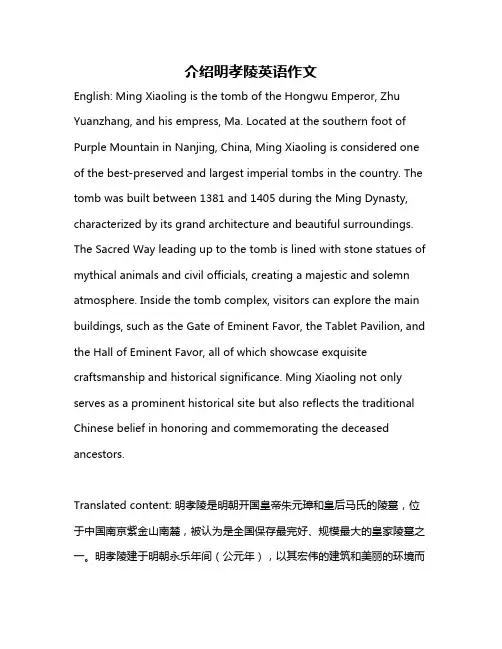
介绍明孝陵英语作文English: Ming Xiaoling is the tomb of the Hongwu Emperor, Zhu Yuanzhang, and his empress, Ma. Located at the southern foot of Purple Mountain in Nanjing, China, Ming Xiaoling is considered one of the best-preserved and largest imperial tombs in the country. The tomb was built between 1381 and 1405 during the Ming Dynasty, characterized by its grand architecture and beautiful surroundings. The Sacred Way leading up to the tomb is lined with stone statues of mythical animals and civil officials, creating a majestic and solemn atmosphere. Inside the tomb complex, visitors can explore the main buildings, such as the Gate of Eminent Favor, the Tablet Pavilion, and the Hall of Eminent Favor, all of which showcase exquisite craftsmanship and historical significance. Ming Xiaoling not only serves as a prominent historical site but also reflects the traditional Chinese belief in honoring and commemorating the deceased ancestors.Translated content: 明孝陵是明朝开国皇帝朱元璋和皇后马氏的陵墓,位于中国南京紫金山南麓,被认为是全国保存最完好、规模最大的皇家陵墓之一。
明孝陵英文导游词
明孝陵英文导游词篇一:明孝陵英文导游词XiaolingTombofthemingdynasty XiaolingTombofthemingdynasty (TodaywewillvisitXiaolingTombofthemingdynasty,whichwasadoptedasth eworldsculturalHeritagein20XX) XiaolingTombisthemausoleumofzhuY uanzhang,thefoundingemperorofthe mingdynasty600yearsago.Theconstructionofthemausoleumstartedin1381, andwascompletedin1413when“theTabletofGreatmeritsofthemingTomboft heGreatmingdynasty”waserected.EmperorzhuY uanzhangwasborninapeasantfamilyofanhuiProvincein1328. HelosthisparentsinhischildhoodandbecameamonkatHuangjueTemple.in13 52hejoinedtheRedTurbanarmyandbecamecommandinggenerallater.in1368 ,heestablishedhisempireandmadenanjingthecapitalwithanameofmingforhi sdynasty.in1398,hediedandwasburiedhereintheXiaoling. Themausoleumconsistsoftwomajorsections.Thefrontse ctionstartsfrom”Th eGatewayofdismountingHorses”attheFalialGuardtotheLingxingGateatthe endofSacredway.Thewholeapproachis1800meterslong.TheGatewayofdis mountingHorseisengravedwith6chinesecharactersforwarningworshipers, meaning”alltheofficialsmustdismountfromthehorsebackhere”.Go700metersnorthwestfromthegateway,wecanseeathree-archedgate.itisknownasthetheGreatGoldenGate,whichisthefrontgateofthemausoleum,conne ctingwiththeredenclosurewalls. GothroughtheGrandGoldenGateisarooflesspavilion,whichiscalledSquarec ity.inthemiddleofthepaviliontherestandsahugestonetablet,whichis8.78mhi ghwith2,746characterscarvedonit.Thisis”theTabletofGreatmeritsofthemin gTomboftheGreatmingdynasty”.Thecharacterswerewrittenbyzhudi,thethir demperorofthemingdynasty.GooutoftheSquarecity,we’llcometothefirstsectionoftheSacredway.TheSacredwayisdividedintotwose ctions.Thefrontsectionisflankedby12pairsofstoneanimalsin6kinds:eachkin doftheanimalshas2pairs,onestandingandonekneeling.Theanimalsarearrang edinproperorder:lions,Xiezhi,camels,elephants,unicornsandhorses. Gostraightalittlebitforward,wecanseetwopillars,fromwherethesacredwaym akesarightturn.Here,weareatthesecondsectionoftheSacredway,whichisflan kedby4pairsofstonewengzhongs:2pairsofgeneralsand2pairsofofficials. attherightofthispath,wecanseeasmallhillplantedwiththousandsofplumtrees. itisthePlum-BlossomHill,whichisSunQuan’stomb.TheHillisnowawonderfulsiteforlocalpeopletoappreciateplumblosso minspringwhenthetreesareblooming.attheendoftheSacredway,thereisagatenamedLingxingGatewiththreearches. itisalsocalleddragon&PhoenixGate.TherearsectionofthemausoleumstartsfromLingxingGatetothecitadelofTreasureandtheTombmound.about270metersawaynortheastoftheLingxingGatethere’sastonebridgespanningoverasmallstream,whichiscalledtheGoldenwaterBri dge,.about200metersnorthofthebridgeisthefrontgateofthetomb.attherightof thegatethereisatabletstone,whichisinscribedwith“TheSpecialnotice”in6for eignlanguagestocallforattentiontoprotectthetomb.Thetabletwasestablished byQinggovernment.insidethegateisatabletpavilion,whichistheentrancehallofthetomb.inthispavi lion,there’satabletinscribedwith“TheSteleofadministratingthecountryasprosperousas theTangandSongdynasties”.TheinscriptionwaswrittenbyKangxi,theemper oroftheQingdynastywhenhewaspayinghishomagetotheentombedemperord uringhisthirdinspectiontourtotheareain1699.Gooutofthepavilion,we’llcometothesiteoftheSacrificialHall.Theoriginalhallwasverylargeandwasus edtoenshrineEmperorzhuYuanzhangandhisempress.Thehallwasdestroyedi nthewaryetits56stonecolumnbasesarestillthere. continuethevisittowardsnorthacro ssabigstonebridge,wecansee“Thecitadel ofTreasuresandtheTombmound”.ThecitadelofTreasuresisthesiteofgraveyar dandtheTombmoundisthetombitself.Thecitadelis39meterslongfromwestto eastand18meterswidefromnorthtosouth.climbup54steps,comingintoourvie wistheTombmound,whichishalfcircledbyastonewall.inthemiddleofthewallthereare7chinesecharacters,meaning”Thehillistheverytomboftheming’sfoundingEmperor”.Thetombiscoveredbyalargemound-400metersindiame ter.EmperorzhuYuanzhangandhisempressareentombedintheunderground.F orthetechnicalreasonsofpreservation,thetombhasnotbeenexcavated.篇二:明孝陵导游词明孝陵景点概况各位游客,我们现在来到的便是明孝陵。
介绍明孝陵英语作文
介绍明孝陵英语作文Nestled within the verdant hills of Nanjing, Ming Xiaoling stands as a monumental testament to the grandeur and rich history of the Ming Dynasty. This mausoleum complex, dedicated to the founding emperor of the dynasty, Zhu Yuanzhang, and his queen, Ma, is not just a place of rest for the royal couple; it's a vivid snapshot of the cultural, artistic, and architectural brilliance of its time.The scale of Ming Xiaoling is immense, with over 200 buildings and structures spread across a vast area. The complex is divided into two main parts: the "Sacred Way" and the "Mausoleum Area." The Sacred Way, a long processional avenue leading to the main mausoleum, is lined with stone statues of various sizes and shapes, representing the dignity and power of the emperor. These statues, along with the elaborate carvings and sculptures adorning the road, exude a sense of awe-inspiring grandeur. The Mausoleum Area, on the other hand, is the heart of the complex. Here, the main mausoleum, the "Tomb of Zhu Yuanzhang," stands tall, surrounded by a wall of stoneterraces. Inside, the tomb is a serene and peaceful space, filled with the tranquility of the dead emperor and his queen. The intricate carvings and paintings on the wallsand ceilings add a touch of elegance to the otherwise austere interior.But Ming Xiaoling's charm doesn't just lie in its grandeur. It's also in the intricate details that make up the complex. From the delicate carvings on the stonetablets to the intricate patterns on the roof tiles, every element tells a story of the care and attention paid to the construction of this mausoleum. It's these details thattruly bring the history and culture of the Ming Dynasty to life.Moreover, Ming Xiaoling is not just a mausoleum complex; it's also a place of profound cultural significance. It's where the emperors of the Ming Dynasty were buried, and as such, it holds a special place in the hearts of the Chinese people. It's a symbol of respect and reverence for the past, a reminder of the rich history and culture that have shaped China into what it is today.In conclusion, Ming Xiaoling is much more than just a mausoleum; it's a historical and cultural landmark that tells the story of the Ming Dynasty. Its grandeur, detail, and significance make it a must-visit destination for anyone interested in Chinese history and culture. As one walks through its vast expanse, it's hard not to be moved by the sense of awe and respect that this place evokes. Ming Xiaoling is truly a testament to the splendor of the Ming Dynasty.**明孝陵:明朝辉煌历史的见证**坐落在南京郁郁葱葱的山峦之中,明孝陵不仅是明朝开国皇帝朱元璋及其皇后马氏的陵墓,更是明朝文化、艺术和建筑辉煌的生动写照。
南京明孝陵英语导游词
南京明孝陵英语导游词(经典版)编制人:__________________审核人:__________________审批人:__________________编制单位:__________________编制时间:____年____月____日序言下载提示:该文档是本店铺精心编制而成的,希望大家下载后,能够帮助大家解决实际问题。
文档下载后可定制修改,请根据实际需要进行调整和使用,谢谢!并且,本店铺为大家提供各种类型的经典范文,如演讲致辞、总结报告、心得体会、合同协议、条据文书、策划方案、导游词、教学资料、作文大全、其他范文等等,想了解不同范文格式和写法,敬请关注!Download tips: This document is carefully compiled by this editor. I hope that after you download it, it can help you solve practical problems. The document can be customized and modified after downloading, please adjust and use it according to actual needs, thank you!Moreover, our store provides various types of classic sample essays for everyone, such as speeches, summary reports, insights, contract agreements, documentary evidence, planning plans, tour guides, teaching materials, complete essays, and other sample essays. If you want to learn about different formats and writing methods of sample essays, please stay tuned!南京明孝陵英语导游词钟山风景区以钟山(紫金山)和玄武湖为中心,包括84个可供观光游览的景点,分为明孝陵景区、中山陵景区、灵谷景区、头陀岭景区和其他景点五大部分。
明孝陵英文导游词Xiaoling Tomb of the Ming Dynasty
Xiaoling Tomb of the Ming Dynasty(Today we will visit Xiaoling Tomb of the Ming Dynasty, which was adopted as the Worlds Cultural Heritage in 2003)Xiaoling Tomb is the mausoleum of Zhu Yuanzhang, the founding emperor of the Ming Dynasty 600 years ago. The construction of the mausoleum started in 1381, and was completed in 1413 when “the Tablet of Great Merits of the Ming Tomb of the Great Ming Dynasty” was erected.Emperor Zhu Yuanzhang was born in a peasant family of Anhui Province in 1328. He lost his parents in his childhood and became a monk at Huangjue Temple. In 1352 he joined the Red Turban Army and became commanding general later. In 1368, he established his empire and made Nanjing the capital with a name of Ming for his dynasty. In 1398, he died and was buried here in the Xiaoling.The mausoleum consists of two major sections. The front section starts from”The Gateway of Dismounting Horses”at the Falial Guard to the Lingxing Gate at the end of Sacred Way. The whole approach is 1800 meters long. The Gateway of Dismounting Horse is engraved with 6 Chinese characters for warning worshipers, meaning”All the officials must dismount from the horse back here”.Go 700 meters northwest from the gateway, we can see a three-arched gate. It is known as the the Great Golden Gate, which is the front gate of the mausoleum, connecting with the red enclosure walls.Go through the Grand Golden Gate is a roofless pavilion, which is called Square City. In the middle of the pavilion there stands a huge stone tablet, which is 8.78m high with 2,746 characters carved on it. This is” the Tablet of Great Merits of the Ming Tomb of the Great Ming Dynasty”. The characters were written by Zhu Di, the third emperor of the Ming Dynasty.Go out of the Square City, we’ll come to the first section of the Sacred Way. The Sacred Way is divided into two sections. The front section is flanked by 12 pairs of stone animals in 6 kinds: each kind of the animals has 2 pairs, one standing and one kneeling. The animals are arranged in proper order: lions, Xiezhi, camels, elephants, unicorns and horses.Go straight a little bit forward, we can see two pillars, from where the sacred way makes a right turn. Here, we are at the second section of the Sacred Way, which is flanked by 4 pairs of stone Weng Zhongs: 2 pairs of generals and 2 pairs of officials.At the right of this path, we can see a small hill planted with thousands of plum trees. It is the Plum-Blossom Hill, which is Sun Quan’s tomb. The Hill is now a wonderful site for local people to appreciate plum blossom in spring when the trees are blooming.At the end of the Sacred Way, there is a gate named Lingxing Gate with three arches. It is alsocalled Dragon& Phoenix Gate. The rear section of the mausoleum starts from Lingxing Gate to the Citadel of Treasure and the Tomb Mound.About 270 meters away northeast of the Lingxing Gate there’s a stone bridge spanning over a small stream, which is called the Golden Water Bridge,. About 200 meters north of the bridge is the front gate of the tomb. At the right of the gate there is a tablet stone, which is inscribed with “The Special Notice” in 6 foreign languages to call for attention to protect the tomb. The tablet was established by Qing government.Inside the gate is a tablet pavilion, which is the entrance hall of the tomb. In this pavilion, there’s a tablet inscribed with “The Stele of Administrating the country as prosperous as the Tang and Song Dynasties”. The inscription was written by Kangxi, the emperor of the Qing Dynasty when he was paying his homage to the entombed emperor during his third inspection tour to the area in 1699.Go out of the pavilion, we’ll come to the site of the Sacrificial Hall. The original hall was very large and was used to enshrine Emperor Zhu Yuanzhang and his empress. The hall was destroyed in the war yet its 56 stone column bases are still there.Continue the visit towards north across a big stone bridge, we can see “The Citadel of Treasures and the Tomb Mound”. The Citadel of Treasures is the site of graveyard and the Tomb Mound is the tomb itself. The citadel is 39 meters long from west to east and 18 meters wide from north to south. Climb up 54 steps, coming into our view is the Tomb Mound, which is half circled by a stone wall. In the middle of the wall there are 7 Chinese characters, meaning” The hill is the very tomb of the Ming’s founding Emperor”. The tomb is covered by a large mound-400 meters in diameter. Emperor Zhu Yuanzhang and his empress are entombed in the underground. For the technical reasons of preservation, the tomb has not been excavated.。
- 1、下载文档前请自行甄别文档内容的完整性,平台不提供额外的编辑、内容补充、找答案等附加服务。
- 2、"仅部分预览"的文档,不可在线预览部分如存在完整性等问题,可反馈申请退款(可完整预览的文档不适用该条件!)。
- 3、如文档侵犯您的权益,请联系客服反馈,我们会尽快为您处理(人工客服工作时间:9:00-18:30)。
明孝陵英文导游词XiaolingTomboftheMingDynasty明孝陵景点概况各位游客,我们现在来到的便是明孝陵明孝陵坐落在紫金山第三峰天堡山之阳独龙阜下,是明朝开国皇帝朱元璋和皇后马氏的陵墓,始建于明朝洪武十四年,完工于永乐十一年孝陵之名,一说是因为朱元璋主张“以孝治天下”,另一说是因为皇后马氏死后谥号“孝慈”,故称孝陵到清代才称“明孝陵”朱元璋1328年出生于安徽凤阳一个贫苦农民的家庭,17岁投身皇觉寺,1352年参加了元末郭子兴的红巾军,1356年领兵攻克南京,1368年登基称帝,定都南京明孝陵依托紫金山,陵园依山就势神道蜿蜒曲折,陵寝恪守中国建筑之传统,中轴对称,首创了宝城宝顶,前朝后寝的陵墓形制开创了明清600多年帝王陵墓之先河为全国重点文物保护单位,2003年列入世界文化遗产名录大金门、碑亭各位游客,现在我们所看到的就是明孝陵的第一道大门------大金门大金门又称大红门,是正式进入陵区的第一道大门,门有三拱,中门较大,两侧稍矮稍低原是重檐歇山顶,通体红色上覆黄色琉璃瓦,可惜毁于战火经过大金门,我们所见的便是碑亭碑亭建于明永乐十一年,重檐歇山顶,亭顶毁于清代咸丰年间太平天国与清军的战争中,仅存四壁,因其四四方方,犹如一个古城堡,所以俗明孝陵是明朝开国皇帝朱元璋和皇后马氏的合葬墓,位于紫金山南麓独龙阜玩珠峰下,是我国现存古代最大的帝陵之一,也是南京地区规模最大,保存最完好的一座帝王陵墓,距今已有600多年的历史1381年孝陵正式动工修建,第二年,马皇后病逝,先于朱元璋葬入地宫,因朱元璋以孝治天下,又因马皇后谥号“孝慈”,故将陵墓命名为“孝陵”,1398年朱元璋驾崩,同年葬入孝陵朱元璋原名朱重八,1328年出生于安徽濠州一个贫苦的农民家庭,小时候父母双亡,他做过乞丐,也当过和尚1352年参加了元末农民起义军郭子兴部红巾军,1368年平定了天下,在南京称帝,国号明,年号洪武,1398年朱元璋逝世,享年71岁现在,明孝陵是国家5A级风景名胜区,并于2003年7月作为“明清皇家陵寝”的拓展项目被列入《世界文化遗产名录》相比于明朝之前的一些帝王陵墓,明孝陵有它的神秘之处,一般陵寝的神道都是直的,而唯独它却是弯曲的,绕过了梅花山,体现了因地制宜,但这其中的典故我会在稍后为大家揭晓明孝陵另一个独特的地方在于它开创了明清陵寝的格局——前朝后寝这种建筑布局反映了封建礼制,突出的是政治和皇权现在在我们面前的呢是大金门,又称大红门,它是明孝陵的正门,也是正门进入陵区的第一道大门门有三券,中门较大,两侧稍矮稍低大金门原为单檐歇山顶,覆盖黄色琉璃瓦,用绿色琉璃椽子,朱红双扉,庄严华丽,可惜已毁于战火在大金门北约70米处便是碑楼,他原来为黄色琉璃瓦重檐歇山顶,明孝陵导游词(2011-10-1918:26:06)转载▼标签:分类:国导证考试资料2011现场考试总统府教育明孝陵各位游客,我们即将参观的景点就是位于紫金山独龙阜玩珠峰的明孝陵明孝陵始明代开国皇帝明太祖朱元璋及其皇后马氏的合葬墓朱元璋1328年出生于安徽凤阳一个贫苦农民的家庭,17岁投身皇觉寺,1352年参加了元末郭子兴的红巾军,1356年领兵攻克南京,1368年登基称帝明孝陵修建于1381年,1382年葬入皇后马氏,1398年朱元璋病逝后入葬于此,工程直到1413年才完工取名孝陵,一说是因为朱元璋主张“以孝治天下”,另一说是因为马皇后死后谥号“孝慈”故此陵明代称“孝陵”,到清代始称“明孝陵”,以示朝代的区别明孝陵各位游客,我们即将参观的景点就是位于紫金山独龙阜玩珠峰的明孝陵明孝陵始明代开国皇帝明太祖朱元璋及其皇后马氏的合葬墓朱元璋1328年出生于安徽凤阳一个贫苦农民的家庭,17岁投身皇觉寺,1352年参加了元末郭子兴的红巾军,1356年领兵攻克南京,1368年登基称帝明孝陵修建于1381年,1382年葬入皇后马氏,1398年朱元璋病逝后入葬于此,工程直到1413年才完工取名孝陵,一说是因为朱元璋主张“以孝治天下”,另一说是因为马皇后死后谥号“孝慈”故此陵明代称“孝陵”,到清代始称“明孝陵”,以示朝代的区别明孝陵依托紫金山,陵园依山就势神道蜿蜒曲折,陵寝恪守中国建筑之传统,中轴对称,首创了宝城宝顶,前朝后寝的陵墓形制开创了明清600多年帝王陵墓之先河为全国重点文物保护单位,2003年列入世界文化遗产名录现在我们看到的就是明孝陵的第一道大门-------大金门,当年明孝陵陵区从大金门的两侧延伸出一道45华里的外墙,把整个紫金山都包括在内原大金门重檐歇山顶,顶覆有黄色琉璃瓦,现在屋顶和大门都荡然无存了只剩城座以及三拱门过大金门,我们就来到了四方城,这里原来是一座碑亭,由于顶部毁于清代咸丰年间的战火,只留下了四面墙壁和四个门券,每边长米,犹如一个四四方方的古城堡,所以南京人俗称它为“四方城”,城内有一座“大明孝陵神功圣德碑”碑高米,下面的碑趺高米,称赑屃,传说为龙生九子之一,好负重,这块碑是南京地区最大的一块明碑碑文是由明成祖朱棣所撰,全文有2746个字,共分为七部分,一、叙述其身世,出生句容大族;二、为民请命,发迹定远;三、平定天下,登基称帝、册中宫、立皇太子,分封同姓;四、废中书、设六部,亲掌兵权;五、重人才、建国学;六、生活简朴,嘱死后与马氏合葬孝陵;七、皇族子女57人名号及144句四言颂词一篇,碑文是对朱元璋一生的高度评价“大明孝陵神功圣德碑”的落成是在1413年,这也是明孝陵工程结束的标志朱棣在大书特书朱元璋功绩的背后其实是在大树特树自己的威信,以此表明继承皇位的正统他原本在南京东郊的阳山派上万民工凿了一块巨大的碑材,其碑帽、碑身、碑座如果相加高达72米,因为过于巨大无法搬运因而弃之未用走过御河桥,我们就来到了明孝陵的神道,神道共分为二段,第一段是石象路,路的两侧从东往西依次排列有六种石兽,每组四只,两立两蹲狮子是百兽之王,象征帝王的威严;獬豸是传说中的法兽,象征君王的正直不阿;骆驼乃沙漠之舟,展示大明疆域辽阔,国家西域安宁;大象则是象征国泰民安,民心顺服;麒麟是中国神话传说的一种瑞兽,象征帝王的仁德;最后看到的这种动物是马,象征对帝王的忠诚在神道两侧安置这些石兽的主要目的一是表记朱元璋的功绩,二是展示大明的国力昌盛,三是祈望镇妖辟邪走过石像路,前方是神道的第二段,翁仲路在路口有一对望柱,望柱又称华表,立于陵墓前的神道,又称陵表在这里有指示道路的作用,从这里开始,神道开始拐向正北方向翁仲路上有两对武将,身穿盔甲,手执金吾,身材魁梧;两对文臣,身穿朝服,手捧笏板,神情肃穆他们分别是一对青年的,一对壮年的,预示着大明江山后继有人神道的尽头,立有一座六柱三门的棂星门,原门毁于清咸丰年间的战火,现在看到的这座棂星门是根据史料在2007年修复的这是谒陵时通行的礼仪之门在石象路东侧,有一座小山,叫梅花山,神道围绕梅花山转了一个弯原来这座山是东吴时孙权的陵墓,在修明孝陵时曾有人建议将此墓移走,但朱元璋说:“孙权也是一条好汉,就留下给我看大门吧”,于是神道因此而弯曲,正好成为了明孝陵的天然屏障现在这里已经成为南京著名的赏梅基地了现在我们看到的是金水桥,金水桥的后方就是明孝陵的陵寝建筑,金水桥原本有五座,正对着陵宫的五座大门,后毁于清咸丰年间的战火,清代只重新修复了三座,我们可以看到桥面与桥基的石雕任然是明代遗物,桥栏为清代重修从这里开始,建筑依照中国传统,坐北朝南,中轴对称顺坡而上,我们首先看到的是文武方门,这是陵宫的大门它黄瓦,朱门,红墙,相互映衬,尽显皇家的气派这座门是1988年根据史料重修的大门,在门前在墙外的东侧,有一座特别告示碑,立于宣统元年,上面用日德意法英俄六国文字书写,内容是告诫游人要保护孝陵进了文武方门,我们就来到了碑殿,碑殿原为孝陵享殿前的大门,因大门在太平天国的战火中,清同治年间将毁坏的大门改建为碑殿,殿内共有五块碑刻,正中一块上刻“治隆唐宋”,为康熙皇帝手书,意思是赞誉朱元璋治理国家的功绩超过了唐太宗李世民、宋太祖赵匡胤作为满清皇帝的康熙如此昭示天下,一方面表示了他对朱元璋的尊重和钦佩之意,另一方面也是有其良苦用心的康熙执政之初,汉人不服满人统治康熙深知,光靠满人高压政策是不行的,还须依靠汉人他一生六次南巡,五次亲谒明孝陵,行三跪九叩的大礼,并在1699年第三次南巡谒陵时题“治隆唐宋”,借此笼络人心作为旁边两块是乾隆皇帝谒陵时所题的诗碑后面还有两块卧碑分别记叙康熙皇帝第一次和第三次南巡时谒太祖陵的纪事,上面有两江总督陶岱以及江南织造郎中曹寅所书的记录这座建筑是孝陵原主要建筑享殿,即孝陵殿旧址,可以看到原有汉白玉的三层须弥座台基,台基高三米,三层台基的四角上还遗留石雕的螭首,台基前后各处踏跺三道塌跺中置丹陛上陛为“二龙戏珠”,中陛为“日照山河”,下陛为“天马行空”三层须弥座上为享殿,里面是供奉朱元璋及马皇后的神位原来的殿宇毁于清咸丰年间的战火,我们现在看到台基地面上保留下来的56个巨大的石柱础,每个的直径都有米,看到这里就不难想象当时的享殿是多么的壮观当年的孝陵殿面阔九间,进深五间,重檐庑殿顶,上覆黄色琉璃瓦,斗拱挑檐,高大森严,当时孝陵的规模远比北京十三陵明成祖的长陵享殿要大现在我们看到的是清代同治年间修复的三开间的小殿,规模已大不如前经过内红门,走过升仙桥,眼前的建筑就是方城,方城是宝顶前面的一座巨大建筑,外部用大条石与巨大的砖石砌成,方城东西两侧各有八字墙一堵,墙面四角饰有砖雕花纹,这些砖雕是明代初年的代表作品穿过方城正中54级甬道,迎面就是宝城的南墙,正面可见用十三层条石垒筑,上书“此山明太祖之墓”七个大字,据说这七个字刻于民国初年,是用以回答游人询问的从宝城与方城之间的东西夹道折向南拾级而上,可以登上明楼,它原先是一座重檐歇山顶,上覆黄色琉璃瓦的精美建筑,后毁于清代太平天国的战火,仅存四壁,2009年明楼加顶保护工程完成,已修复上午明楼于2009年7月正式对游客开放,里面展出了明代分布在全国的十九处帝王陵墓的图片资料方城后面就是宝顶,它是一个直径325---400米的圆形大土丘,宝顶上树木参天,它的下面就是朱元璋马皇后埋葬的玄宫宝城就是围绕宝顶周长约1100米的砖城宝城宝顶的皇陵形制开创了明清500多年帝陵的先河只是明代的宝顶大致为圆形,清代帝陵的宝顶改为椭圆形了今天在明孝陵的东侧还保存有明太子朱标的东陵遗址,在当年明孝陵陵区钟山之阴还建有数座明代功臣墓阿中国古代的帝王陵墓形制最初为秦汉时的方上,代表陵墓为陕西的秦始皇陵,唐代改为依山为陵,代表陵墓有陕西唐高宗李治与女皇武则天的唐乾陵,宋代帝王陵为规模比较小的方上,明代朱元璋首创了宝城宝顶、前朝后寝的陵墓形式明朝自1368年建都,至1644年灭亡,前后有16位皇帝,除南京明孝陵外,其余皇陵均在北京,只有建文帝朱允炆没有陵墓诸多的明代陵墓遗存给我们留下了无数观赏之处中国古代陵墓作为中国文化的遗存,为后人研究与了解中国古代经济与文化留下了重要的实物资料各位游客朋友,我们今天的参观就要这里结束,感谢大家对我的导游工作的配合,欢迎您再次游览明孝陵!。
